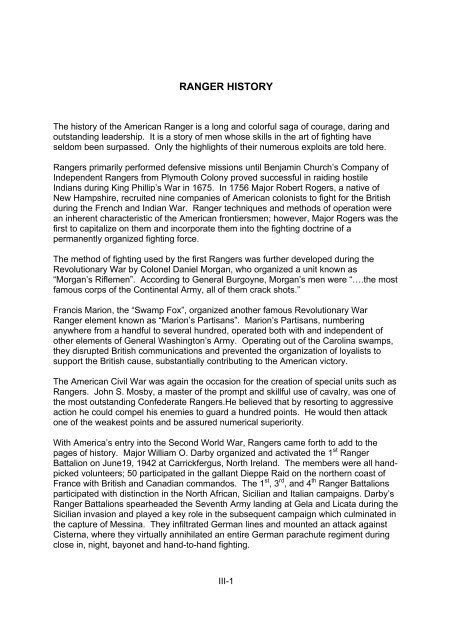Create successful ePaper yourself
Turn your PDF publications into a flip-book with our unique Google optimized e-Paper software.
<strong>RANGER</strong> HISTORY<br />
The history of the American Ranger is a long and colorful saga of courage, daring and<br />
outstanding leadership. It is a story of men whose skills in the art of fighting have<br />
seldom been surpassed. Only the highlights of their numerous exploits are told here.<br />
Rangers primarily performed defensive missions until Benjamin Church’s Company of<br />
Independent Rangers from Plymouth Colony proved successful in raiding hostile<br />
Indians during King Phillip’s War in 1675. In 1756 Major Robert Rogers, a native of<br />
New Hampshire, recruited nine companies of American colonists to fight for the British<br />
during the French and Indian War. Ranger techniques and methods of operation were<br />
an inherent characteristic of the American frontiersmen; however, Major Rogers was the<br />
first to capitalize on them and incorporate them into the fighting doctrine of a<br />
permanently organized fighting force.<br />
The method of fighting used by the first Rangers was further developed during the<br />
Revolutionary War by Colonel Daniel Morgan, who organized a unit known as<br />
“Morgan’s Riflemen”. According to General Burgoyne, Morgan’s men were “….the most<br />
famous corps of the Continental Army, all of them crack shots.”<br />
Francis Marion, the “Swamp Fox”, organized another famous Revolutionary War<br />
Ranger element known as “Marion’s Partisans”. Marion’s Partisans, numbering<br />
anywhere from a handful to several hundred, operated both with and independent of<br />
other elements of General Washington’s Army. Operating out of the Carolina swamps,<br />
they disrupted British communications and prevented the organization of loyalists to<br />
support the British cause, substantially contributing to the American victory.<br />
The American Civil War was again the occasion for the creation of special units such as<br />
Rangers. John S. Mosby, a master of the prompt and skillful use of cavalry, was one of<br />
the most outstanding Confederate Rangers.He believed that by resorting to aggressive<br />
action he could compel his enemies to guard a hundred points. He would then attack<br />
one of the weakest points and be assured numerical superiority.<br />
With America’s entry into the Second World War, Rangers came forth to add to the<br />
pages of history. Major William O. Darby organized and activated the 1 st Ranger<br />
Battalion on June19, 1942 at Carrickfergus, North Ireland. The members were all handpicked<br />
volunteers; 50 participated in the gallant Dieppe Raid on the northern coast of<br />
France with British and Canadian commandos. The 1 st , 3 rd , and 4 th Ranger Battalions<br />
participated with distinction in the North African, Sicilian and Italian campaigns. Darby’s<br />
Ranger Battalions spearheaded the Seventh Army landing at Gela and Licata during the<br />
Sicilian invasion and played a key role in the subsequent campaign which culminated in<br />
the capture of Messina. They infiltrated German lines and mounted an attack against<br />
Cisterna, where they virtually annihilated an entire German parachute regiment during<br />
close in, night, bayonet and hand-to-hand fighting.<br />
III-1


